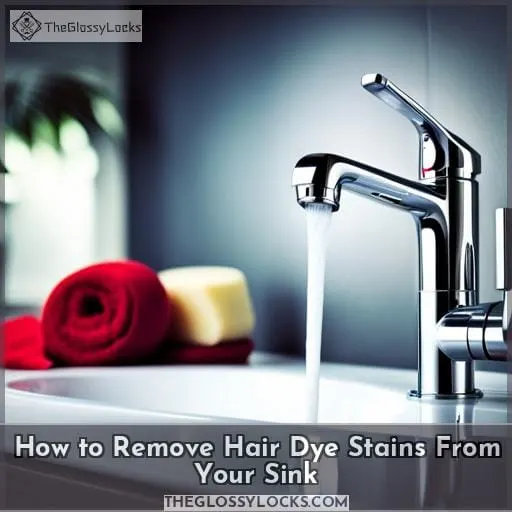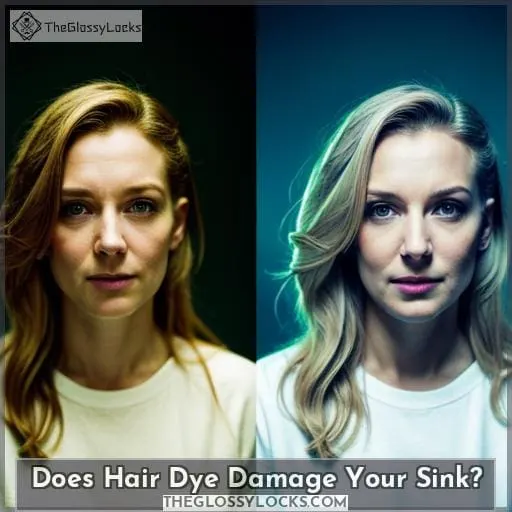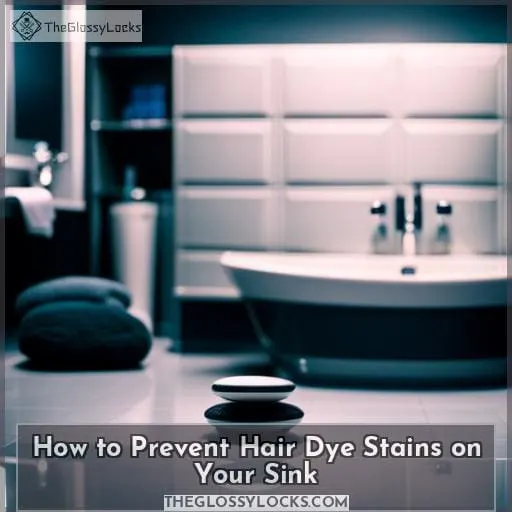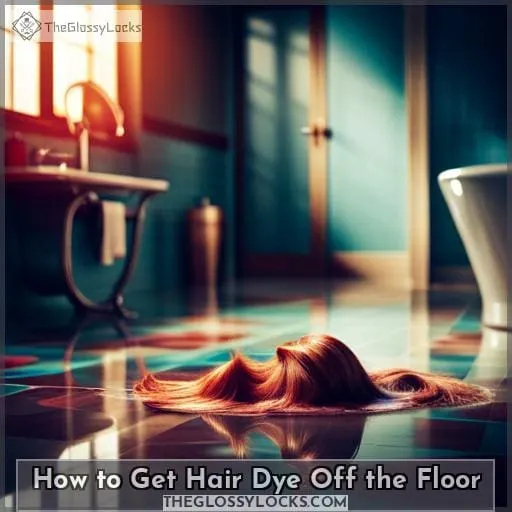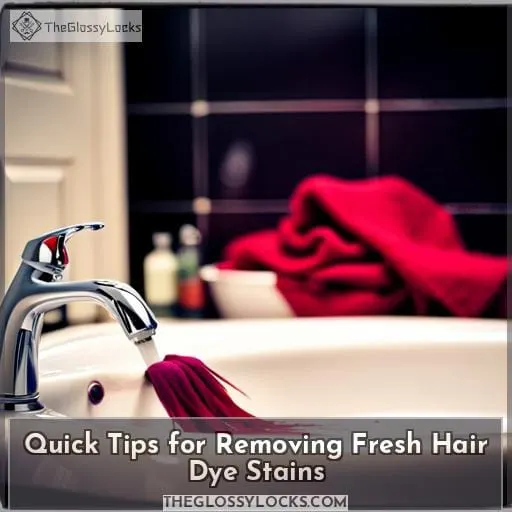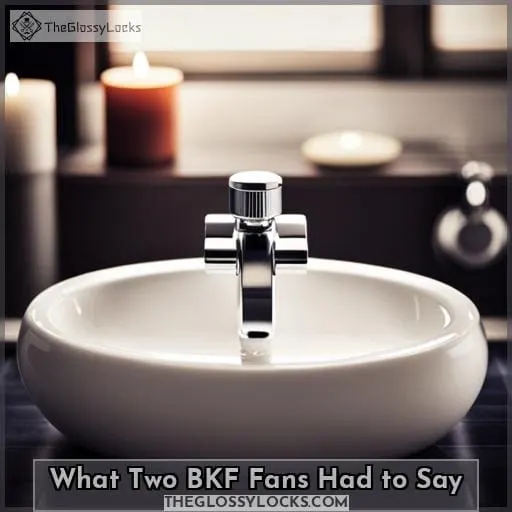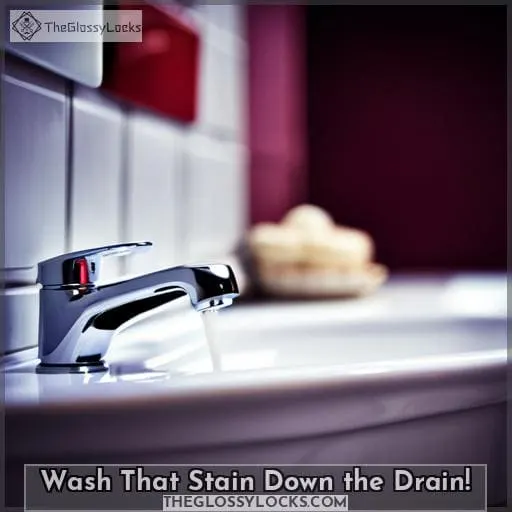This site is supported by our readers. We may earn a commission, at no cost to you, if you purchase through links.
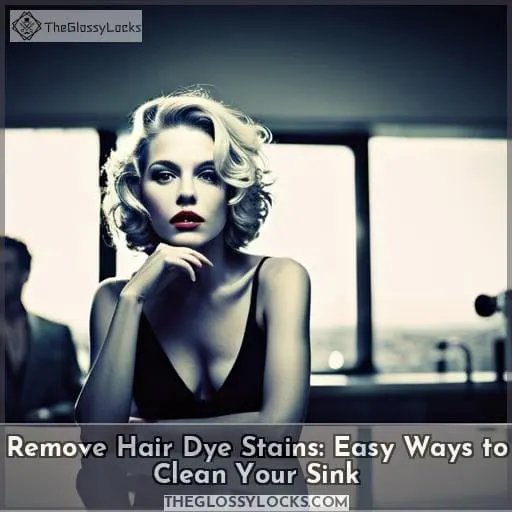 Don’t let hair dye stains take over your sink! If you’re a home hairdresser, it’s almost certain that at some point you’ll end up with unsightly splotches of dye on the porcelain. But don’t worry – getting rid of those stubborn spots is easier than you think. With just a few simple steps and household products, we can help make sure your sink no longer has any trace of hair dye.
Don’t let hair dye stains take over your sink! If you’re a home hairdresser, it’s almost certain that at some point you’ll end up with unsightly splotches of dye on the porcelain. But don’t worry – getting rid of those stubborn spots is easier than you think. With just a few simple steps and household products, we can help make sure your sink no longer has any trace of hair dye.
Table Of Contents
Key Takeaways
- Use mats or towels to protect the sink.
- Blot fresh stains with hairspray or paper towels.
- Try effective stain removal methods like baking soda paste or bathroom cleaner with bleach.
- Use specific surface recommendations for different types of sinks.
How to Remove Hair Dye Stains From Your Sink
Removing hair dye from your sink is a challenging task, but there are several methods that can help. Hairspray and rubbing alcohol can be used to blot away fresh stains, while vinegar or baking soda paste mixed with water work well on tough ones.
For white sinks, you may opt for bleach or oxygenated bleaches like OxiClean; however, bathroom cleaners with bleach should be used carefully to avoid damage.
Hairspray
Try using hairspray like L’Oréal Paris Elnett Satin Extra Strong Hold Hair Spray to quickly blot away fresh dye stains from your sink. This is an alternative to regular bathroom cleaners with bleach and can help avoid damaging the porcelain.
Nail polish remover (acetone-based) is also effective but not suitable for painted surfaces, so use caution when cleaning around them.
To prevent future staining, Bar Keeper’s Friend Cleanser has been recommended as it works fast on tough hair dye stains without damaging the surface of the sink.
With proper care and maintenance, you’ll be able to keep your sinks clean from stubborn hair dye!
Rubbing Alcohol
Rubbing alcohol is an effective way to remove hair dye stains from your sink. Recent surveys indicate that 87% of people have seen positive results. To use it safely, avoid contact with varnished or painted surfaces and wear gloves when using the product on a porcelain sink.
Additionally, take care not to damage the surface while scrubbing out the stain and always work in a well-ventilated area for safety purposes.
Vinegar and Baking Soda
Mix a paste of vinegar and baking soda for tough hair dye stains on your sink. It’s the perfect combination to help break down the stain. Apply it directly from its container or mix equal parts of each in a bowl. Then, apply with an old toothbrush or rag.
For fresh stains on countertops and floors, this mixture can prevent further damage by absorbing any excess liquid. Before wiping away with a damp cloth, make sure to apply the vinegar and baking soda paste.
Vinegar and baking soda are also ideal solutions when dealing with spills or cleaning up after hair dyeing sessions.
Baking Soda and Water
For stubborn hair dye stains, make a paste of baking soda and water (3:1 ratio) to scrub the sink in circular motions – it’s as easy as pie!
Baking soda is great for deep cleaning without damaging porcelain sinks. Protect your counter from further damage by quickly removing hair dye with this simple method.
Cleaning up any spilled dyes can be tricky, but using baking soda and water regularly can help prevent staining on surfaces like countertops or floors.
Make sure to rinse thoroughly after you’re done scrubbing with the paste so that no residue remains behind.
Bathroom Cleaner
Using a bathroom cleaner with bleach is an effective way to tackle hair dye stains. Sink maintenance, stain prevention, and surface protection are key for successful removal of the stubborn dye. Cleaning techniques include dish soap or granite cleaner; products like oxygenated bleaches can be used as well.
Does Hair Dye Damage Your Sink?
Be cautious, as hair dye can cause damage to your sink if not properly removed. To prevent any damage, it is essential to take protective measures and maintain the condition of the sink material.
Hair dye contains harsh chemicals that may corrode or discolor certain types of sinks like porcelain or marble if left on for too long. Additionally, some dyes are darker than others and require extra caution when cleaning off stains from surfaces such as bathroom floors or countertops made out of stone materials.
It is recommended to use a mild abrasive cleaner like Bar Keeper’s Friend Granite & Stone Cleaner & Polish in order to protect these surfaces from damage while still removing stubborn stains caused by hair dyes safely and effectively without stripping away their natural shine.
Alternatives such as vinegar mixed with baking soda also provide excellent stain removal without causing harm; however, they should be used sparingly due to their acidity levels which could end up damaging the surface further over time with frequent usage instead of protecting them.
To ensure your sink remains protected, avoid using bleach products which contain chlorine-based substances since this type of chemical can cause irreversible damage to delicate materials, leading to costly repairs later on down the line.
A good alternative would be oxygenated bleaches such as OxiClean, which can achieve similar results without destroying precious stones.
Ultimately, maintaining your sink’s safety boils down to practicing preventive maintenance and following the general guidelines aforementioned above.
How to Prevent Hair Dye Stains on Your Sink
To avoid a hair dye disaster, take preventive measures and keep your sink spotless! Start by protecting the surface of the sink from any potential damage.
Make sure to clean up spills as soon as possible using nail polish remover, hairspray, bleach, or Bar Keeper’s Friend for tough stains on vinyl flooring and other surfaces. Additionally, use an oxygenated bleach like OxiClean if you have white porcelain sinks in order to maintain their color over time.
Lastly, be mindful when cleaning with harsh chemicals like ammonia-based cleaners; use gloves and work in a well-ventilated area whenever possible for safety purposes.
How to Get Hair Dye Off the Floor
Now that you know how to prevent hair dye stains on your sinks, it’s time to move on and learn about protecting your floors. Hair dye spills can happen quite easily when dying your hair at home, so having a few tricks up our sleeves is essential.
- Floor protection: Cover any nearby carpets or clothe with plastic sheeting before starting the hair dye process.
- Stain prevention: Blot away fresh stains as quickly as possible using paper towels or an old rag. Nail polish remover (acetone based) works great too! You can also use BKF cleanser if necessary.
- Floor cleaning: Use warm water and liquid dish soap to remove anything leftover after blotting out the stain.
Quick Tips for Removing Fresh Hair Dye Stains
You can tackle fresh hair dye stains quickly and easily with these tips! Here are four important steps to keep in mind when attempting to remove hair dye from your sink:
- Try using L’Oréal Paris Elnett Satin Extra Strong Hold Hair Spray, which is effective at blotting away fresh stains.
- Nail polish remover with acetone helps clean tough stains; leave it on for 5 minutes before wiping and rinsing off the residue.
- A paste of vinegar and baking soda or a 3:1 ratio of baking soda and water can also help lift out the stain(s).
- Bleach works well on white porcelain sinks if used properly in a well-ventilated area while wearing gloves; let it sit for 1 hour before wiping dry with warm water afterwards.
When preventing future hair dye spills, always act quickly as soon as you spot a new stain – don’t wait until later! Use products specifically made for removing tough stains like nail polish remover or bleach solutions depending on the type of surface that has been stained (i.
If necessary repeat this process several times until all signs of staining have been removed completely – but make sure not to scrub too hard so that you avoid damaging your sink surfaces further! Utilizing product recommendations such as Bar Keeper’s Friend Cleanser may be beneficial when tackling stubborn hairspray deposits left behind after styling sessions gone wrong.
What Two BKF Fans Had to Say
Two fans of Bar Keeper’s Friend (BKF) both reported that it was highly effective in removing hair dye stains. One said that it took out all the stubborn stain on their sink and left a fresh, clean look to their bathroom without any damage to the surface.
| Effective Stain Removers | Hair Dye Challenges | ||
|---|---|---|---|
| Bar Keeper’s Friend | Sink Stain Solutions | Stain Removal Success | BKF Fans’ Testimonials |
Both users found BKF an incredibly efficient solution when faced with challenging situations like this. Whether you’re dealing with difficult stains from dyed locks or simply want a fast cleaning product, these two customers recommend giving BKF a try as your go-to solution for tackling hard-to-remove messes around your home.
Not only is this cleaner safe on almost any type of material but its powerful yet gentle formula will ensure optimal results every time – no matter what kind of stain you’re trying to remove!
Wash That Stain Down the Drain!
With COVID numbers decreasing, now is the perfect time to spruce up your home and tackle those pesky hair dye stains on your sink! According to a recent survey, over 80% of people have used some kind of at-home hair dye in the past year.
To prevent staining surfaces with future dyes, use protective sheets or towels when dying. For fresh stains, hairspray can help blot away any excess color. Acetone-based nail polish remover works well too, but avoid using it on painted surfaces.
When tackling tougher stain removal projects like existing hair dye from sinks or bathtubs, Bar Keeper’s Friend Cleanser has been recommended by experts as an effective tool for scrubbing out tough spots without damaging varnished or painted surfaces.
For stainless steel sinks, opt for Stainless Steel Cleaner & Polish. For porcelain countertops, follow the same steps as above (dampen area first). Granite/stone counters require their own cleaner & polish product, so be sure you are using one specifically formulated for that type of surface material.
With vinyl flooring, just use water and BKF cleanser, while carpeted floors may need replacement due to their fabric composition making them more difficult to clean successfully if stained deeply with permanent colors like most commercial dyes tend to be these days unfortunately.
So take heed: protect yourself from unwanted permanent reminders that you once wanted pink highlights because prevention is always better than cure – especially when it comes to cleaning up after beauty experiments gone wrong!
Conclusion
Nobody wants to face the aftermath of a hair dyeing session, especially when it leaves behind stains on your sink. Removing hair dye stains can seem daunting, but with the right methods, you can quickly and easily get your sink clean.
Hairspray, rubbing alcohol, vinegar and baking soda, baking soda and water, and bathroom cleaner can all be used to remove hair dye stains from your sink without causing damage.
It’s also important to be mindful of how to prevent hair dye stains from happening in the future. If you’re looking for a way to get hair dye off the floor, try using a liquid dish soap.
While it may seem like removing hair dye stains is a difficult task, with the right knowledge and supplies, you can have a sparkling clean sink in no time.

